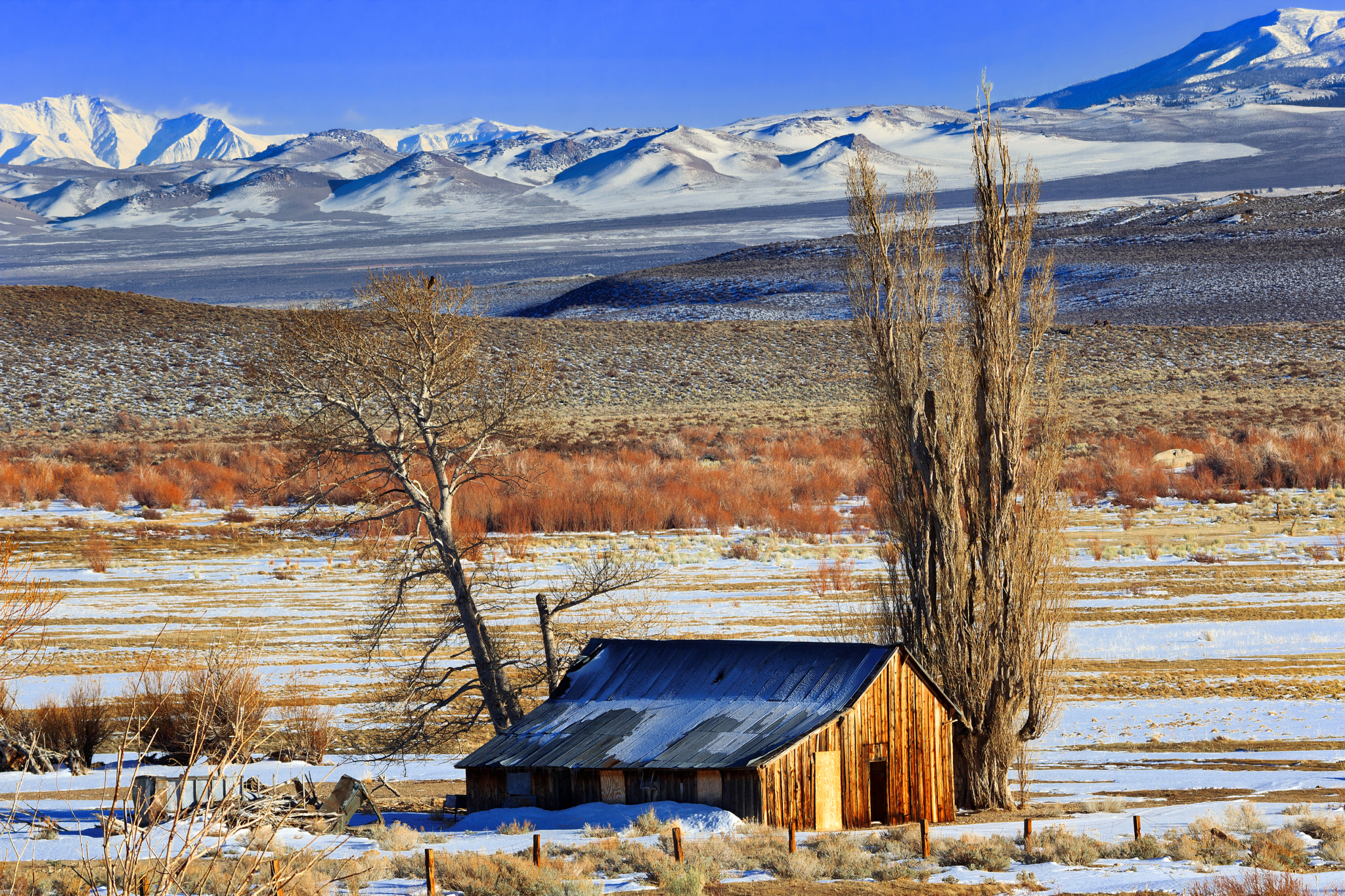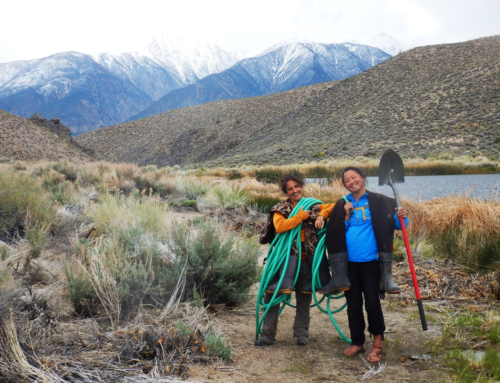Cooperation can feel like a rare event these days. But when the future of one of Mono County’s most iconic panoramas was in question, true cross-agency teamwork and innovative thinking led to real action and success. On December 1, the Eastern Sierra witnessed a major conservation victory: the permanent protection of Conway Ranch. Representatives from Mono County, Eastern Sierra Land Trust, Caltrans, California Department of Parks and Recreation, and the National Fish & Wildlife Foundation have come together to create a conservation easement and management plan that keeps Conway Ranch wild and scenic, and working to benefit our local economy for generations to come.

Conway Ranch’s green, irrigated summer meadows frame the view of Mono Lake that thousands of visitors marvel at every year. Photo © Rick Kattelmann.
Looking down on Mono Lake from the viewpoint just below Conway Summit, Eastern Sierra residents and visitors alike have marveled at the picturesque expanse of Conway Ranch. Comprised of two distinct properties the Conway and Mattly Ranches, which are sometimes referred to collectively as “Conway Ranch” the 800+ acre stretch of open space and agricultural land northwest of Mono Lake is one of the most beloved landscapes in the Eastern Sierra region. Its significant wetlands, springs, and irrigated meadows are critical to supporting wildlife. The Mono Lake mule deer herd migrates twice a year through the property on the way to and from its winter range in Nevada and summer grazing lands in the High Sierra. Conway Ranch also provides the perfect mix of habitats for the greater sage-grouse, a rare, ground-nesting bird that is currently being considered for listing as a threatened species. In addition, the property’s freshwater springs and wet meadows are important breeding and nesting grounds for a large variety of waterfowl and shorebirds that reside in the area or migrate along the Pacific Flyway every year.

Long used by Native Americans, sheep ranchers, and more recently for commercial fish-rearing, Conway Ranch also holds important wildlife habitat, wetlands, and incredible scenic vistas.
Conway Ranch also represents a vital component of the Eastern Sierra’s cultural heritage. Once an important stop along Native American trade routes, in the 1870s settlers created lush pastures by diverting water from nearby creeks to raise livestock and vegetables to feed hungry miners in Bodie. The Conway family bought the property in 1903 and some of the original homestead and ranch buildings still stand to this day. Commercial fish rearing has also occurred on the property in raceways and ponds for more than 30 years and has proven to be an important economic resource for Mono County.
In the early 1990s, this property was the focus of an approved large-scale housing and resort development. Recognizing what was at stake, Mono County worked with The Trust for Public Land and several funding agencies to achieve a major success in land preservation by purchasing the property from the developer. The County obtained grant funds from Caltrans; California Department of Parks and Recreation (State Parks); and the National Fish and Wildlife Foundation. These grants were designed to protect the natural, open space, scenic, historic, and public access values of the property, while allowing for the continuation of certain existing uses, including fish-rearing and grazing.
Several years ago, discussions between Caltrans and Mono County about current and future uses of the property resulted in agreement to lift Caltrans grant restrictions on a 75-acre portion of the property to allow for enhanced aquaculture infrastructure, such as a hatchery, while clarifying protections on the rest of the property. So Mono County and Caltrans partnered with ESLT to implement an innovative solution. ESLT Conway Ranch Project Manager and former Executive Director Karen Ferrell-Ingram notes that the parties came to a consensus that, “a conservation easement could ensure that the property’s special resources are maintained, while creating flexibility for Mono County to develop a sustainable fish-rearing facility. We worked with the original grantors to incorporate their restrictions into the easement and to create a new management plan. It was a long and complex process and we really appreciated the involvement of local residents and others to make it a better agreement in the end.”

Thanks to two years of cooperative efforts between Mono County, Eastern Sierra Land Trust, and funding partners, the historic Conway Ranch property is now protected forever. Photo © Kathleen Bishop.
A conservation easement is a voluntary and permanent legal agreement between a willing landowner and a land trust or agency that restricts the future use of the property to protect certain natural, agricultural, or historic resources. Mono County will continue to own and manage the property and ESLT’s role will be limited to monitoring and enforcing the terms of the conservation easement.
After two years of conversations about the future of Conway Ranch and input from the public, state and federal wildlife agencies, the original granting agencies, and local nonprofits, a final Conway Ranch conservation easement and management plan was completed on December 1. Chairman of the Mono County Board of Supervisors, Larry K. Johnston commented that, “this is a historic moment in Mono County history and clearly demonstrates our dedication to environmental stewardship and sustainable economic development.”
The future of Conway Ranch is no longer a question. “The Conservation Easement will allow for Mono County to realize the economic and fish rearing potential of Conway Ranch, while also protecting important natural and historic resources for generations to come,” stated Acting Caltrans District 9 Director Mike Beauchamp. Wildlife habitat and water resources will be protected forever, and compatible activities such as livestock grazing and fish rearing will continue in a manner that ensures the protection of the surrounding resources.

The Conway Ranch conservation easement permanently preserves the property’s incredible resources and provides for the enhancement of aquaculture facilities and continued historic uses.
ESLT Executive Director Kay Ogden envisions that, “our descendants will stand at Conway Summit and look southward over the Mono Basin, and marvel at the same open expanse of wild lands that stunned the first settlers centuries before. Rare birds will visit lush irrigated meadows with their young, and the mule deer will follow in their ancestor’s hoof prints as they have for millennia. This, is a victory.”
This unusual example of cross-agency cooperation ensures that future generations will be able to enjoy the unique and beautiful vistas, wildlife, open spaces, and history of Conway Ranch forever.






[…] will continue our work in Swall Meadows through August, and will also be traveling out to Conway Ranch in the months ahead to clear debris and pull invasive weeds. You can keep up-to-date on […]
[…] Nellie Deli (not included), we’ll carpool out just north of Mono Lake to our recently protected Conway Ranch Conservation Easement. There, we’ll be joined by important project partners from Caltrans and Mono County for an […]
I’m a descendant of the Conway family. The other side of my family settled Elko. Where they are buried which
Includes my grandfather Robert Conway born 1906